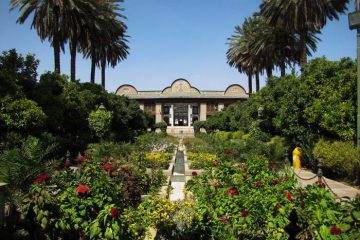Naqsh-e Rustam,Tomb of Darius
Naqsh-e Rustam is an ancient necropolis, located near Persepolis and 68 km northeast of Shiraz city. Naqsh-e Rustam Shiraz is the necropolis of the Achaemenid Dynasty (550–330 BC) and contains rock-reliefs from the Sassanid era (224–651 AD). Naghsh-e Rostam counts as one of the top Shiraz attractions, paired with Persepolis.
A historic treasury lies in the Naqsh-e Rustam tombs location. Naghshe Rostam Shiraz is where the tomb of Darius I is located. According to the Naqsh-e Rustam inscription, archaeologists have discovered which great kings reside in Naqsh e Rustam burials. Inside Naqsh e Rustam tombs lacks any special design, however, there are carved the Naqsh-i Rustam inscriptions on the façade. Naghshe Rostam relief is like an ancient family album of the Achaemenids.(To visit Naqsh-i Rustam inscriptions the address and opening hours are included in the end.)
If you wish to visit Iran, we as an Iran travel agency invite you to have a look at our Iran travel packages:
>> Iran Tours 2020 & 2021 (Click Here)
A Necropolis on a Cliff Overlooking a Plain Encircled by Mountains
Once Darius I the Great (522-486 BC) decided where he wanted to sleep his everlasting sleep, his descendants as well, followed his footsteps. However, the mountain Darius I the Great had chosen was already considered significant location in the former dynasties which we will unfold its mysteries to you as you continue reading.
The spectaculars rock tombs at Naqsh-e Rustam are carved from a cliff high above the ground. The resting place of four great Achaemenid kings is as majestic as a burial site can get.
#1 Where Are Naqsh-e Rustam Burials?
Naqsh-e Rustam burials are situated about five kilometres northwest of Persepolis which once was the capital of the ancient Achaemenid Empire; near the city of Shiraz.

#2 Where to Visit First in Naghshe Rostam Shiraz?
There are more than just one site to visit while in Naghshe Rostam Shiraz. It is important to have a pre-planned schedule to not miss anything.
We have made a list out of them, organizing them according to their importance:
- The four royal tombs hewn out of the mountain
- Ka’ba Zartosht (Zarathustra’s cube) in front of the royal tombs
- The Sassanid inscriptions and reliefs

#3 What Does the Name “Naqsh-e Rustam” Mean?
Some of the reliefs of Naghshe Rostam Shiraz show elaborate equestrian fights of a type that was still common in the Middle Ages, about the time when the famous poet Ferdowsi (940-1021) wrote the Shahnameh, the Iranian national epic, full of tales of chivalry.

It seems that people who knew those stories, when they saw the equestrian reliefs, thought that they represented the legendary hero Rustam in the poems of Ferdowsi. This can explain why the site was called Naqsh-e Rustam, “carvings of Rustam“.
#4 Naqsh-e Rustam Inscription
There are multiple Naqsh-e Rustam inscription on each monument. One of the Naqsh e Rustam inscriptions belong to the royal tomb of Darius I the Great; however, the other three royal tombs can only tentatively be attributed to Xerxes (northeast of Darius I), Artaxerxes I (southwest of the tomb of Darius I) and Darius II (westernmost) due to lack of any inscriptions.

The other Naqsh e Rustam inscriptions are the ones on Ka’ba Zartosht (the cube of Zarathustra’s cube). Probably, this tower looking construction was used to keep the holy fire or books (e.g., the Avesta); all but theories waiting to be confirmed.
#5 Illustrating Naghshe Rostam Relief
Three sets of Naghshe Rostam relief is distinguishable on the cliff:
Naghshe Rostam relief dating back to the Elamite Dynasty;
A portrait of a man with a hat that is pointing forward and a long dress-like garment (clothing not similar to the Achaemenes and Sasanians) can still be discerned on the extreme right of the relief which has been carved over by a Sasanian relief
Naghshe Rostam relief dating back to the Achaemenid Dynasty;
Above the cross façade of Darius I the Great tomb is a panel with a relief which depicts Darius I, whose hands are raised in a gesture of worship, standing on a three-stepped pedestal in front of an altar.
Naghshe Rostam relief dating back to the Sassanid Dynasty.
The Sasanians as an attempt to make a connection with the Achaemenes they carved reliefs on the rock walls of Naghshe Rostam Shiraz.

#6 Architecture of Naqsh-e Rustam Tombs
The façade of the Naqsh-e Rustam tombs looks like a Salib (‘crosses’ in Persian). The four Naqsh-e Rustam tombs follow the same pattern, however, completely different from that of the older tomb of Cyrus the Great.
The model was primarily used for Darius I and has no exact prototypes in the Near East, Egypt or Greece, though the stone technique is Urartian in origin.

The exterior architecture is characterized as a cruciform composition. The architectural facade recalls the palace of the living monarch because of the portico’s dimensions on the tomb of Darius I which are almost identical to those of his palace on the terrace of Persepolis.
#7 How Does Inside Naqsh e Rustam Burials Look Like?
Inside Naqsh e Rustam burials has a very simple interior of chambers and grave cists.
In contrast to the rich design of the faced, the interior is bare of any architectural and figural elements. The best demonstration of the general layout is with the tomb of Darius I: A long vestibule running parallel to the facade, along with three doors in the back wall of this vestibule are leading to three separate barrel-vaulted tomb chambers.

Naghshe Rostam Opening Hours
Everyday, 8 AM to 7 PM
How to Get to Naqsh e Rustam



1 Comment
Nate · July 9, 2019 at 2:10 pm
Amazing! We visited the site right after visiting Persepolis. The rock reliefs were so fine and full of ancient history and symbolism, as our guide explained to us!